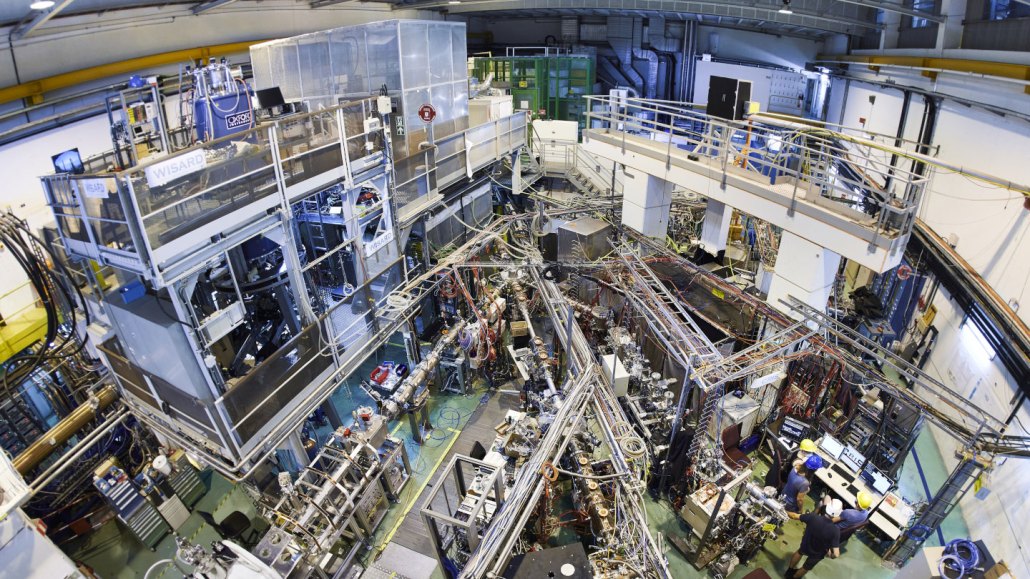
To observe a radioactive decay that’s key to building a nuclear clock, scientists used the nuclear physics facility ISOLDE at CERN near Geneva (pictured).
CERN
- More than 2 years ago
Hickory dickory dock, this nucleus could make a great clock.
A special variety of the element thorium hosts an atomic nucleus that could be used to keep time, scientists say. In a first, researchers have measured a type of decay of this thorium nucleus that releases a single particle of light. The measurement of the energy released in the decay is seven times as precise as estimates based on different types of decays, researchers report in the May 25 Nature. The improved energy measurement could galvanize work toward the first nuclear clock, which would follow in the footsteps of atomic timepieces.
“We have already amazing atomic clocks which run very precisely,” says nuclear physicist Sandro Kraemer of KU Leuven in Belgium. Those atomic clocks are based on the physics of the electrons that surround an atom (SN: 10/5/17). A nuclear clock would be based on the atom’s nucleus. Some scientists believe nuclear clocks could be even more precise than atomic clocks, which are already such powerful tools that they’re used in everything from GPS satellites to experiments that test whether fundamental laws of physics hold true (SN: 6/4/21).
The well-established technology of atomic clocks is based on how an atom’s electrons jump into a higher energy state. It takes a specific frequency of light, with just the right amount of energy, to initiate the jump. The oscillation of that light acts like the ticking of a clock. A nuclear clock would be based on similar energy jumps made by a nucleus.
Most atomic nuclei have energy levels too far apart to allow scientists to set the jump off with a laser — a necessity for building a clock. But a particular variety, or isotope, of thorium called thorium-229 has two energy levels unusually close together — about 8 electron volts. Still, no one has been able to initiate the jump with a laser, because the size of that energy gap wasn’t precisely known until now.
Kraemer and colleagues measured the energy released when the thorium-229 nuclei decayed, jumping down in energy from its higher energy state. First, the team had to get thorium-229 into that high-energy state, which is called an isomer. One way to do that is to start from another element that can decay into the thorium isomer. Using a radioactive beam at the ISOLDE facility at the European physics lab CERN near Geneva, the team embedded actinium-229 into crystals of calcium fluoride and magnesium fluoride. The actinium-229 decayed, producing the thorium-229 isomer.
This technique helped scientists sidestep a sticking point. Normally, thorium-229 decays in a way that makes the energy difficult to measure, by transferring its energy to an electron and kicking it out of the atom. A decay that emits a particle of light, or photon, is much easier to measure, but it normally happens only once in a billion decays.
Embedding the thorium-229 into the crystals suppressed the decay that is more difficult to measure, making the single-photon decay dominate. That allowed the researchers to detect the single photons from isomer decays and measure their energy. The researchers estimated the decay had an energy of 8.338 electron volts. That figure agrees with earlier measurements of how far apart the two energy levels are, but is much more precise.
“This is a milestone that people have been looking for,” says quantum physicist Simon Stellmer of the University of Bonn in Germany, who was not involved with the study. Previous claims of detecting this type of decay haven’t held up, Stellmer says. “This seems to be the first true and real observation of this isomer decay.”
Physicists are now working to use a laser to set off the energy transition, going from the low-energy state to the higher-energy isomer, in the next step toward creating a nuclear clock. “It is actually something that we in our lab are trying to do,” says physicist Ekkehard Peik of the National Metrology Institute of Germany in Braunschweig, who was not involved with the new research. “That’s why we are very excited.”
A nuclear clock could provide a new angle on physics phenomena. “It would be very interesting to compare conventional atomic clocks and nuclear clocks because the underlying physics … is different,” Peik says. For example, nuclear clocks could reveal subtle variations in fundamental constants of nature (SN: 11/2/16).
Another bonus of going nuclear: The clocks could be made with nuclei inside a solid material, as opposed to atomic clocks, in which atoms must be suspended inside a vacuum chamber. That means a nuclear clock could be more stable and make measurements more quickly, Kraemer says.







